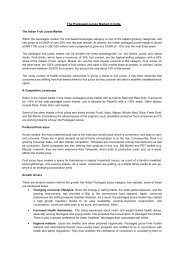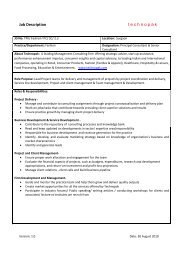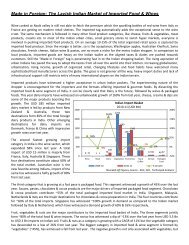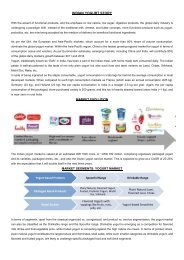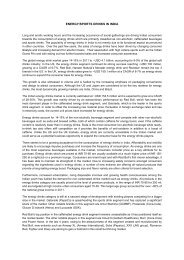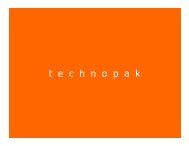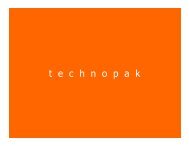a quarterly report by - Technopak
a quarterly report by - Technopak
a quarterly report by - Technopak
You also want an ePaper? Increase the reach of your titles
YUMPU automatically turns print PDFs into web optimized ePapers that Google loves.
perspective<br />
a quar terly repor t <strong>by</strong><br />
increase its gross margin from its product sales greatly, it has been able to increase its profitability <strong>by</strong><br />
increasing the share of revenue from other income streams like income from supplier/brands, rental and<br />
display income and services like air conditioner installation. As shown in Exhibit 4, GOME has been able<br />
to increase its gross income significantly which has resulted in gross margin improvement. Typically, most<br />
of the other income elements involve very little expense for the retailer and hence, contribute directly to<br />
the bottom line. Indian retailers would also need to focus on extracting maximum value from their existing<br />
assets in order to grow profitably.<br />
Inventory Management:<br />
The Key to Profitability<br />
Indian modern retail is still in a very nascent stage with most of the retailers in the early stage of growth.<br />
It is very important for the retail CEOs to invest in robust dashboards to monitor the performance of the<br />
company. Till now, most of the retailers in India were focusing on the top-line growth and product margin<br />
improvement; however, the recent slowdown has forced many of them to rethink on the way key operational<br />
parameters in the business are monitored. While top-line growth, sales per square feet, gross margin,<br />
rentals etc. are important, it is equally important to focus on the inventory. An analysis carried out <strong>by</strong><br />
<strong>Technopak</strong> on inventory management in apparel category (see Exhibit 5) shows that Indian retailers are<br />
way behind their international counterparts on inventory management while almost being at par with them<br />
on gross margin. A higher inventory not only leads to greater risk of markdowns but also results in an<br />
increasing need for working capital further leading to lower ROCE. Further analysis shows that just 1%<br />
increase in sales and gross margin would increase the ROCE <strong>by</strong> 5% and 7% respectively whereas a<br />
reduction of 1 month inventory would lead to a 10% increase in ROCE. Given the current inventory levels of<br />
Indian retailers, an improvement in inventory through better forecasting, replenishment and lesser wastage<br />
can easily decrease inventory levels thus freeing up important capital which can be utilized for expansion<br />
plans.<br />
Exhibit 5<br />
Average Indian<br />
Inventory<br />
Inventory Management-A Comparison Between Indian and Internationl Retailers<br />
40% 44%<br />
110<br />
81<br />
260<br />
Days of Inventory/Sales- Indian<br />
Indian Retailers<br />
51%<br />
93<br />
63%<br />
44%<br />
133<br />
160<br />
40%<br />
58%<br />
60<br />
Raymond Apparel<br />
Fab India<br />
Koutons<br />
Trent<br />
Color Plus<br />
Provogue<br />
Kewal Kiran<br />
Gross Margin- Indian<br />
37%<br />
38<br />
Gap<br />
45% 49%<br />
Nike<br />
Quiksilver<br />
International Retailers<br />
48%<br />
67%<br />
3 times more inventory in India<br />
Liz Claiborne<br />
H&M<br />
Urban Qutfitters<br />
39%<br />
48%<br />
48 50 43 30 34 29<br />
Days of Inventory/Sales- International<br />
Ann Taylor Stores<br />
Volume 02 / 2009<br />
Average International<br />
Inventory<br />
Gross Margin- International<br />
| Volume 02<br />
A Financial Deep Dive into India’s Retail Sector |<br />
6



